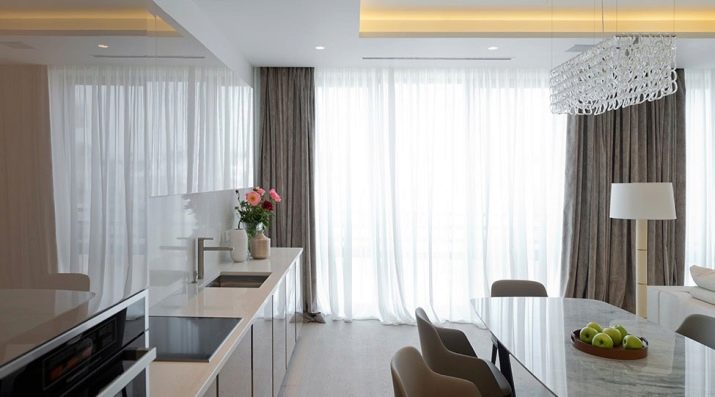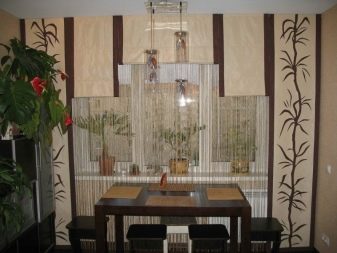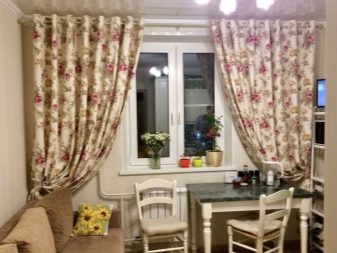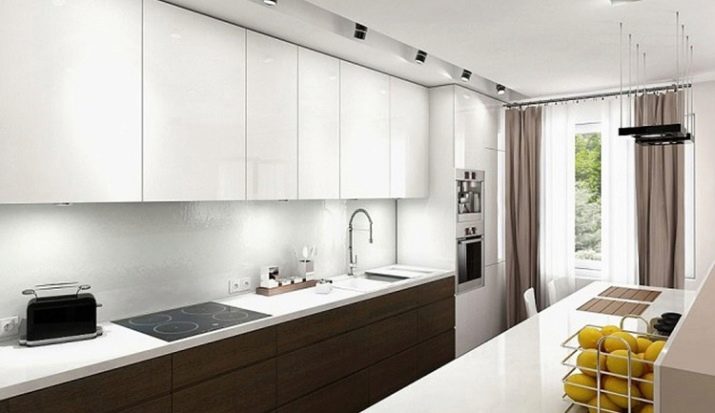The room in the house that is most associated with the warmth and comfort of the hearth is the kitchen. Often, all family members gather in it, which means that it should be not only comfortable, but also pleasing to the eye. The easiest solution to give a "home" atmosphere will be curtains. Particularly beautiful are the long curtains that look down to the floor, covering not only the window itself, but also the space under it. In order to correctly choose such an element of decor, you need to familiarize yourself with the various options and choose the most suitable one from them.

Kinds
There are many types of kitchen curtains that are quite different from each other. Each of them has its own advantages and disadvantages.

Roman
Such curtains are a single canvas with a special lifting mechanism, similar to that used for blinds. Spread out over the entire length, they can cover the entire space to the floor, and when lifting form a uniform "accordion" of small folds. Of the advantages of this type can be noted safety and ease of combination with modern interiors.
Such a cloth can be hung even in cases where the plate is located close enough to the window, because unlike a light draped veil, the Roman curtain hangs motionless and does not flutter from the draft, risking falling into the fire. Among the disadvantages of Roman curtains, it is possible to note the difficulty of leaving and restricting the movement of the window frame in those cases when the window opens into the room.
Before washing, you will have to disconnect the lifting mechanism and remove all rails from the canvas.


Roll
Roller blinds are similar to Roman, but when lifting, the canvas is curled into a neat roll along the fishing line-guide. At the top, such a roller either remains in sight or hides inside a special box. From the advantages of this model, one can distinguish reliable fixation of the canvas, ease of cleaning and low price. The downside is that such curtains often make it difficult to open the kitchen window wide open. Besides, they cannot be cleaned in a washing machine, and the design is so minimalistic that it resembles an office one.


Panel
Such curtains are also called "Japanese", as they resemble high sliding panels. Straight canvases are easy to handle even with very high window heights; some models allow you to organize remote control. They do not need to be removed, washed and ironed, it is enough to wipe them with a damp cloth from time to time.
Of the minuses, one can note the high cost and the conflict of styles with the most common classic interior of most kitchens.


Kisei
This view is a curtain of many long fabric or bead threads. They look very modern and fresh, fit well into almost any interior style. Unfortunately, this option has a lot of drawbacks.in. Do not hang such curtains if the stove is located near the window. Good Kise expensive acquisition. In addition, curtains made of threads and beads are not suitable for those families where there are pets and small children, because the curtains are easily torn and crumble from tension.


Classic
Classic curtains, which are a dense night curtain and / or tulle, continue to be the most sought-after goods. They are absolutely universal, suitable for both classic kitchens and interior novelties. Unlike other species, they have many folds and draperies, which additionally gives coziness to the room, and also easily hide any imperfections in the interior (pipes, balcony doors, batteries).
Of course, like any other type of curtains, such curtains have their drawbacks. They quickly get dirty and saturated with the smell, and removing, cleaning and hanging them is very tedious. They are not always convenient to manage with a long blade length, and a large number of folds near an open fire increases the risk of fire. It is best to choose such an option for planning, where the window is far enough from the stove.


Materials
For sewing curtains in the kitchen, you can use both natural and synthetic fabrics.

Linen
Durable and textured expensive material that almost does not fade in the sun and tolerates frequent machine washings.


Cotton
In its pure form, it wrinkles strongly and sits after washing, so it is better to give preference to a mixture of cotton and synthetics. The fabric will remain strong, but it will not lose color for a long time and will not fade in the sun.


Viscose
The budget version of silk, which, unfortunately, quickly deteriorates from frequent washes. To extend the life of such curtains, lined or mixed materials can be chosen.



Polyester
The most resistant material, which is not afraid of water and the sun, does not crease and does not stretch. Wherein It strongly attracts dust and does not look as beautiful as natural materials.



Design options
In order for the selected curtains to blend harmoniously into the interior of the kitchen, it is necessary to take into account the main features of the style areas.

Classic
Traditional cuisines are great for classic curtains. It is better to choose tulle in white and beige tones, this will visually expand the room and make it brighter.
The color and pattern of the curtains themselves can be combined with the color of furniture, wallpaper or other design elements.


East style
Such curtains accentuate a spacious bright kitchen with a luxurious design. They can become both a color accent of the room, and complement the existing decor, repeating the pattern or pattern of the apron tile or furniture facade.


Provence
For kitchens in Provence style, natural fabrics and light pastel colors are perfect. Such curtains should be lush and airy, have a large amount of drapery and quilling.


Country
If the decoration of the room contains a large number of such natural materials as stone or wood, then you can safely purchase country-style curtains. It can be both monophonic canvases and curtains with the image of flowers, vegetables, birds or butterflies. Also for a similar style, the traditional pattern is an ordinary cell.


High tech
The high-tech kitchen has a lot of chromed metal shine and dark shades. In order to dilute the color scheme, you can afford any curtains of the brightest colors. Wherein it is better to avoid drawings on them, stopping at monophonic options or canvases with geometric patterns.


Minimalism
A similar style also involves the use of plain curtains, however, their colors should remain calm. It can be light beige or dark chocolate. The main thing in minimalism is the high quality of the fabric itself, and not the variegation of colors.


Criterias of choice
There are several important nuances on which you need to focus first when choosing both finished products, and fabrics for sewing curtains.
- Compliance with purpose. Curtains carry not only an aesthetic, but also a practical function. For example, if the windows are located on the shady side of the house, it is better to choose a light tulle, which allows maximum sunlight. And if the apartment is on the ground floor, it is worth choosing curtains that will hide what is happening in the room from the prying eyes of passersby.
- The convenience of use. Kitchen curtains are removed and sent to the wash several times more often than in other rooms. That is why they should be easy to remove and hang, or simply wiped with a damp cloth.
- Wear resistance. Frequent washing, sudden changes in temperature, high humidity - all this negatively affects the state of the kitchen curtains. When buying, you should give preference to more wear-resistant materials.
- Compliance with the general style and color scheme. Soft pink cotton curtains with ruffles will look strange in kitchens with lots of glass and metal. On the contrary, Japanese-style straight curtains are unlikely to fit into a rustic kitchen with lots of decorative details and natural materials.


How to hang and tie?
You can hang the curtains on the ledge in several ways:
- clothespins on the rings;
- using ordinary hooks;
- on grommets;
- to the eyeballs.



And so that the dense fabric of classical curtains does not cover the tulle and does not flutter from the movement of air from the ajar window, the curtains can be tied with special tacks.
- Single curtain most often tied up in the middle or corner.
- Double canvases traditionally tied symmetrically with corners or with a cross.
If you wish, you can diversify the interior by tying double curtains asymmetrically or on one side.

You can learn more about how to choose Roman curtains for the kitchen.










